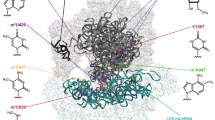Abstract
RNA modifications are present in most cellular RNAs and are formed posttranscriptionally by enzymatic machineries that involve hundreds of enzymes and cofactors. RNA modifications impact the life cycle of the RNA, its stability, folding, cellular localization, as well as interactions with RNA and protein partners. RNA modifications are important for mitochondrial function and are required for proper processing and function of mitochondrial (mt) tRNA and rRNA. Underscoring their importance, several mitochondrial diseases are caused by defects in mt-RNA modifications, stemming from mutations in mtDNA at or near mt-RNA modification sites or in nuclear-encoded mt-RNA modifying enzymes. A highly abundant RNA modification, involved in mitochondrial physiology and pathology is pseudouridylation (Ψ), which is catalyzed by enzymes of the Pseudouridine Synthase (PUS) family. Although some Ψ sites in mt-rRNA and mt-tRNA have been identified, little is known about the functional role of these modifications. Furthermore, it is unknown which enzyme facilitates the modification of each site and it is likely that many yet undiscovered mt-RNA modifications exist, as is evidenced by recent work showing some Ψ sites on mRNA. Here, we present mito-Ψ-Seq, a high-throughput method for semiquantitative mapping of Ψ in mt-RNA.
Access this chapter
Tax calculation will be finalised at checkout
Purchases are for personal use only
Similar content being viewed by others
References
Contreras L, Drago I, Zampese E, Pozzan T (2010) Mitochondria: the calcium connection. Biochim Biophys Acta 1797:607–618
Burke PJ (2017) Mitochondria, bioenergetics and apoptosis in cancer. Trends Cancer Res 3:857–870
Ojala D, Montoya J, Attardi G (1981) tRNA punctuation model of RNA processing in human mitochondria. Nature 290:470–474
Mercer TR, Neph S, Dinger ME et al (2011) The human mitochondrial transcriptome. Cell 146:645–658
Machnicka MA, Milanowska K, Osman Oglou O et al (2013) MODOMICS: a database of RNA modification pathways—2013 update. Nucleic Acids Res 41:D262–D267
Arroyo JD, Jourdain AA, Calvo SE et al (2016) A genome-wide CRISPR death screen identifies genes essential for oxidative phosphorylation. Cell Metab 24:875–885
Auffinger P, Westhof E (1998) Effects of pseudouridylation on tRNA hydration and dynamics: a theoretical approach. In: Modification and editing of RNA. American Society of Microbiology, Washington, DC, pp 103–112
Durant PC, Davis DR (1997) The effect of pseudouridine and pH on the structure and dynamics of the anticodon stem-loop of tRNA (Lys, 3). Nucleic Acids Symp Ser (36):56–57
Motorin Y, Keith G, Simon C et al (1998) The yeast tRNA:pseudouridine synthase Pus1p displays a multisite substrate specificity. RNA 4:856–869
Fernandez-Vizarra E, Berardinelli A, Valente L et al (2007) Nonsense mutation in pseudouridylate synthase 1 (PUS1) in two brothers affected by myopathy, lactic acidosis and sideroblastic anaemia (MLASA). J Med Genet 44:173–180
Zeharia A, Fischel-Ghodsian N, Casas K et al (2005) Mitochondrial myopathy, sideroblastic anemia, and lactic acidosis: an autosomal recessive syndrome in Persian Jews caused by a mutation in the PUS1 gene. J Child Neurol 20:449–452
Zaganelli S, Rebelo-Guiomar P, Maundrell K et al (2017) The pseudouridine synthase RPUSD4 is an essential component of mitochondrial RNA granules. J Biol Chem 292:4519–4532
Antonicka H, Choquet K, Lin Z-Y et al (2017) A pseudouridine synthase module is essential for mitochondrial protein synthesis and cell viability. EMBO Rep 18:28–38
Calvo SE, Clauser KR, Mootha VK (2016) MitoCarta2.0: an updated inventory of mammalian mitochondrial proteins. Nucleic Acids Res 44:D1251–D1257
Safra M, Sas-Chen A, Nir R et al (2017) The m(1)A landscape on cytosolic and mitochondrial mRNA at single-base resolution. Nature. https://doi.org/10.1038/nature24456
Schwartz S, Bernstein DA, Mumbach MR et al (2014) Transcriptome-wide mapping reveals widespread dynamic-regulated pseudouridylation of ncRNA and mRNA. Cell 159:148–162
Safra M, Nir R, Farouq D et al (2017) TRUB1 is the predominant pseudouridine synthase acting on mammalian mRNA via a predictable and conserved code. Genome Res 27:393–406
Carlile TM, Rojas-Duran MF, Zinshteyn B et al (2014) Pseudouridine profiling reveals regulated mRNA pseudouridylation in yeast and human cells. Nature 515:143–146
Lovejoy AF, Riordan DP, Brown PO (2014) Transcriptome-wide mapping of pseudouridines: pseudouridine synthases modify specific mRNAs in S. cerevisiae. PLoS One 9:e110799
Li X, Zhu P, Ma S et al (2015) Chemical pulldown reveals dynamic pseudouridylation of the mammalian transcriptome. Nat Chem Biol 11:592–597
Grinberg M, Schwarz M, Zaltsman Y et al (2005) Mitochondrial carrier homolog 2 is a target of tBID in cells signaled to die by tumor necrosis factor alpha. Mol Cell Biol 25:4579–4590
Minczuk M, He J, Duch AM et al (2011) TEFM (c17orf42) is necessary for transcription of human mtDNA. Nucleic Acids Res 39:4284–4299
Quinodoz SA, Ollikainen N, Tabak B et al (2018) Higher-order inter-chromosomal hubs shape 3D genome organization in the nucleus. Cell 174:744–757.e24
Engreitz JM, Pandya-Jones A, McDonel P et al (2013) The Xist lncRNA exploits three-dimensional genome architecture to spread across the X chromosome. Science 341:1237973
Shishkin AA, Giannoukos G, Kucukural A et al (2015) Simultaneous generation of many RNA-seq libraries in a single reaction. Nat Methods 12:323–325
Van Nostrand EL, Pratt GA, Shishkin AA et al (2016) Robust transcriptome-wide discovery of RNA-binding protein binding sites with enhanced CLIP (eCLIP). Nat Methods 13:508–514
Author information
Authors and Affiliations
Corresponding author
Editor information
Editors and Affiliations
Rights and permissions
Copyright information
© 2021 Springer Science+Business Media, LLC, part of Springer Nature
About this protocol
Cite this protocol
Sas-Chen, A., Nir, R., Schwartz, S. (2021). mito-Ψ-Seq: A High-Throughput Method for Systematic Mapping of Pseudouridine Within Mitochondrial RNA. In: Minczuk, M., Rorbach, J. (eds) Mitochondrial Gene Expression. Methods in Molecular Biology, vol 2192. Humana, New York, NY. https://doi.org/10.1007/978-1-0716-0834-0_9
Download citation
DOI: https://doi.org/10.1007/978-1-0716-0834-0_9
Published:
Publisher Name: Humana, New York, NY
Print ISBN: 978-1-0716-0833-3
Online ISBN: 978-1-0716-0834-0
eBook Packages: Springer Protocols




